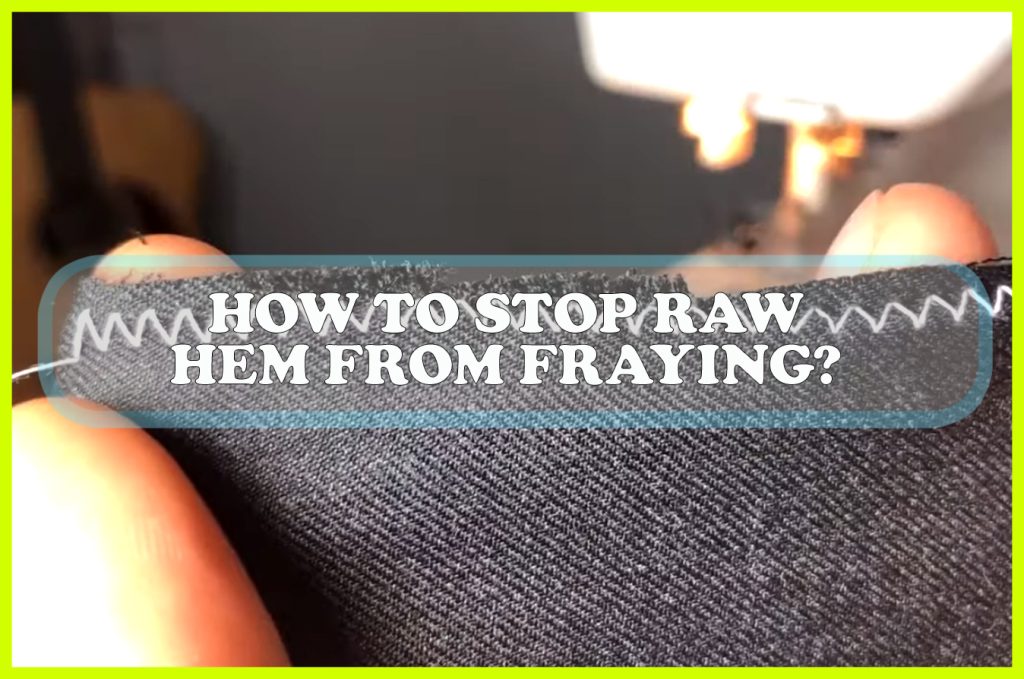To stop raw hem from fraying, you can use a few different methods. One is to use a fray check or a similar product that will seal the edges of the fabric and prevent them from fraying further. Another method is to sew a line of stitches along the raw edge of the fabric to hold it together.
Finally, you can apply a narrow strip of adhesive tape along the edge of the fabric to keep it from fraying any further.
- Purchase a fabric sealant from your local craft store
- Cut away any loose threads or frayed edges from your fabric
- Apply the sealant to the raw edge of the fabric, using a brush or roller to smooth it out
- Allow the sealant to dry completely before wearing or washing your garment
How to Stop Fabric from Fraying After Cutting
If you’re working with fabric, sooner or later you’re going to have to cut it. And when you do, you want to make sure the edges don’t fray. Fraying can ruin the look of your project and make it come apart over time.
There are a few different ways to prevent fraying when cutting fabric. The first is to use pinking shears. Pinking shears have saw-toothed blades that create a zigzag edge on the fabric.
This zigzag edge helps prevent fraying because it’s more difficult for the threads to unravel. Another way to prevent fraying is by sealing the edges of the fabric with a fray check or another similar product. Fray check is a clear liquid that you apply to the edges of the fabric before sewing or after cutting.
It forms a sort of barrier that keeps the threads from coming undone. You can also buy special tape that does basically the same thing as a fray check. A third way to keep fabrics from fraying is by using a serger machine (sometimes called an overlocker).
A serger sews and finishes raw edges in one step by trimming them and encasing them in a thread at the same time. This gives your projects a professional look and feel and prevents any pesky fraying!

How Do You Keep Raw Hem Jeans from Fraying?
One way to prevent raw hem jeans from fraying is by using a product called Fray Check. This clear liquid substance is applied to the fabric and forms a temporary barrier that helps to seal the threads. Another method is to carefully sew a zigzag stitch along the edge of the denim.
This will reinforce the fibers and help prevent them from coming apart. Finally, you can also apply heat to the raw edge with an iron or hair straightener; this will cause the fibers to fuse together and create a more permanent seal. Whichever method you choose, be sure to test it on a scrap piece of fabric first so that you know how it will react with your particular type of denim.
How Do You Secure Raw Edges?
There are a few ways to secure raw edges. The most common way is to serge the edge, which uses an overlock stitch to finish the fabric and prevent it from fraying. You can also use pinking shears or a zigzag stitch on your sewing machine to create a similar effect.
Finally, you can bind the edge with bias tape or ribbon.
Can You Use Hairspray to Stop Fraying?
If you’re looking for a quick and easy way to stop fraying, hairspray is a great option! Simply spray the affected area with hairspray and allow it to dry. The alcohol in the hairspray will help to seal the fibers and prevent them from fraying further.
You can also use clear nail polish for a similar effect.
How Do You Seal Fabric Edges Without Sewing?
If you’re looking for a quick and easy way to finish fabric edges without sewing, there are several ways you can do it. One popular method is using fusible webbing. This is a paper-backed adhesive that comes in various widths and can be found at most craft stores.
To use this method, simply cut a strip of fusible webbing the same width as your fabric edge. Then, iron the webbing onto the wrong side of the fabric following the manufacturer’s instructions. Next, fold the fabric over so that the raw edge is hidden inside and iron again to fuse the two layers together.
Another option for sealing fabric edges is using fray check or a similar product. This is applied directly to the raw edge of the fabric and dries clear, preventing fraying while still allowing you to sew through it if needed. Finally, if you’re looking for a more permanent solution, you can always serge or zigzag stitch around the raw edge of your fabric before washing and drying it according to your project’s instructions.
This will create a finished look that will withstand repeated washings and wearings.
How to Stop Your Fabric From Fraying
Conclusion
If you’re sick of your raw hem jeans fraying, there’s an easy fix. All you need is a little bit of clear nail polish. First, cut off any loose threads.
Then, paint the raw edge with a thin layer of clear nail polish. Let it dry completely before wearing your jeanshair straightener; this will cause the fibers to fuse together and create a more permanent seal again. With just a few coats of nail polish, your raw hem will be good as new and ready to take on anything life throws your way.

